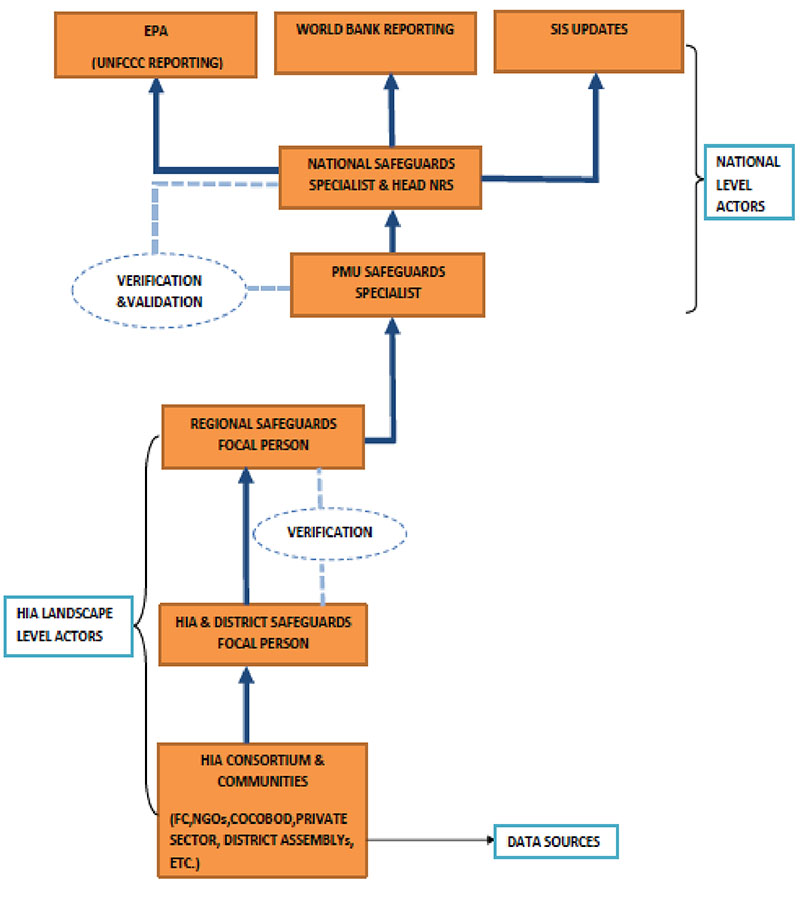Parties to the United Nations Framework Convention on Climate Change (UNFCCC) agreed at the Conference of Parties (COP) in Cancun in December 2010 that seven safeguards should be promoted and supported when undertaking REDD+ activities, and these are known as the ‘Cancun safeguards’ (Decision 1/CP.16 Appendix 1 Paragraph 2). Furthermore, it was also decided in Cancun in 2010 to request developing countries to establish a system for providing information on how these safeguards are addressed and respected throughout the implementation of activities (Decision 1/CP.16, Paragraph 71 (d)) . These have become known as ‘Safeguards Information Systems’ (SIS). At the UNFCCC COP the following year in Durban in 2011 it was decided that countries must provide a summary of information on how all the safeguards have been addressed and respected (Decision 2/CP.17 Paragraph 63 and 64).
The SIS provides information on how REDD+ social and environmental safeguards are being addressed and respected. The objective of a SIS, from the perspective of UNFCCC requirements is to demonstrate that the Cancun safeguards are being addressed and respected during REDD+ implementation. These are the basic objectives that every REDD+ country’s SIS should meet, and countries may initially choose to limit their SIS objectives to meeting these UNFCCC requirements. A further objective could relate to using information from the SIS to prepare a summary of safeguards information, which is also required by the UNFCCC for countries to access and obtain payments for REDD+ results.
Ghana’s SIS will provide information on how safeguards are being addressed and respected throughout implementation of the GCFRP ER programme. The SIS contains indicators for monitoring the compliance on the World Bank Safeguards, Cancun safeguards and other Donor safeguards requirements, Feedback and Grievance Redress Mechanism (FGRM), benefit sharing, co-benefits, etc.
An online web platform has been developed to host Ghana’s REDD+ SIS. Ghana’s SIS web address is www.reddsis.fcghana.org . A SIS design document that clearly describes how the SIS will function (flow of information) has been developed. Ghana submitted its first Summary of Safeguards Information (SoI) to the UNFCCC in June, 2019.
The National REDD+ Secretariat (NRS) has successfully trained Safeguards Focal Persons (SFPs) who are mainly Forestry Commission’s Assistant Regional Managers, Assistant District Managers, and Assistant National Park Managers. They were trained on national and international safeguards requirement as well as Feedback and Grievance Redress Mechanism (FGRM). These focal persons are responsible for the effective monitoring and reporting of safeguards compliance in their various regions and districts. The SFPs led landscape level capacity building programmes where they sensitized relevant Ministries, Departments and Agencies (MDAs) as well as MMDAs and local community leaders who would be involved in the implementation of the REDD+ programme.
The SFPs will also lead the formation of safeguards teams at their various regions and districts for safeguards reporting purposes. The safeguards teams will compose the district/regional safeguards focal person, as well as representatives of HIAs and Consortiums from HIA Management Boards, the private sector, NGOs, District Assembly members, Traditional Authority, and opinion/religious leaders. The teams will be responsible for ensuring safeguards compliance and reporting.
In terms of Safeguards reporting, the regional and district SFPs will collect data and information and in collaboration with the various partners and stakeholders. Once collected, they will ensure that the data and information is reviewed and verified by the safeguards team(s) before it is submitted to the Programme Management Unit (PMU) Safeguards Specialist. The PMU Safeguard Specialist will then forward the programme’s safeguard information and data on to the National Safeguards Specialist for final validation and approval, with the knowledge of the Director for Climate Change. The Director, will give final validation of safeguards information and then trigger reporting to the Environmental Protection Agency (EPA) for the UNFCCC (national communication), the World Bank, and enable web-based publication and updates into the SIS for relevant stakeholders and the general public.

